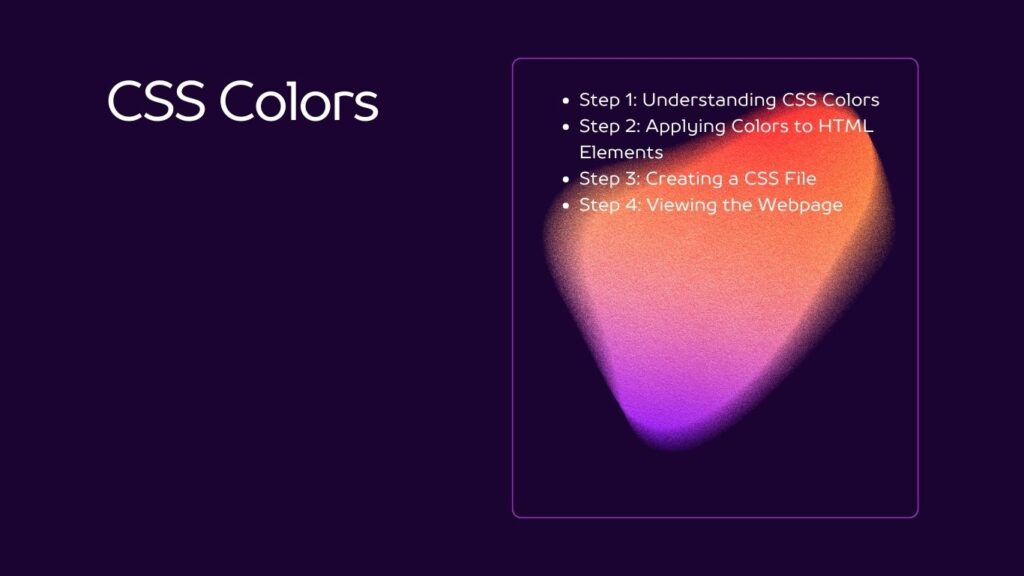Mastering CSS Colors: A Beginner’s Guide to Web Design
Are you ready to embark on a creative journey into the captivating realm of web design? In today’s digital age, a visually striking website is a powerful tool for making a lasting impression. One of the key elements that can transform your web pages into works of art is the skillful use of CSS Colors. In this comprehensive guide, titled “CSS Colors,” we will delve into the fundamental concepts and techniques that will empower you to harness the full potential of color in your web design projects.
In the world of web design, CSS Colors are the artist’s palette, offering an extensive range of shades and tones to infuse life and personality into your websites. Whether you are a beginner or a seasoned developer, understanding how to wield CSS Colors effectively is an essential skill. From the simplicity of named colors to the precision of hexadecimal values and the creative freedom of HSL, this guide will walk you through each method, ensuring you have a firm grasp on how to select and apply the perfect hues to your web elements.
With the knowledge gained from this guide, you will be equipped to breathe life into your web pages. You’ll learn how to choose background colors that set the mood for your site, text colors that ensure readability, and button colors that beckon users to engage. By following our step-by-step instructions and experimenting with sample code snippets, you will gain hands-on experience in creating visually appealing web pages that captivate your audience’s attention.
Whether you aspire to be a web designer, developer, or simply wish to enhance your online presence, mastering CSS Colors is a crucial first step. Join us on this exciting journey as we unlock the potential of CSS Colors and pave the way for your web design endeavors. We will guide you through the intricacies of color selection, ensuring your web pages not only look visually stunning but also rank high in search engine results. Let’s embark on this colorful adventure together, as we explore the world of web design through the lens of CSS Colors.

Table of Contents
Prerequisites
Before we begin, it’s essential to have a basic understanding of HTML since CSS is used to style HTML elements. If you’re new to HTML, you might want to check out an introductory tutorial first. With HTML as the structure of your webpage, CSS will be your tool for making it beautiful.
Step 1: Understanding CSS Colors
Colors in CSS are defined using various methods, including named colors, hexadecimal values, RGB values, and HSL values. Let’s explore each method.
Named Colors
Named colors are predefined color names that you can use in CSS. They are easy to remember and use. Here are some examples:
/* Sample CSS code using named colors */
body {
background-color: aquamarine;
color: darkslategray;
}Hexadecimal Values
Hexadecimal values represent colors using a combination of six characters (0-9, A-F). They start with a #. For example:
/* Sample CSS code using hexadecimal values */
a {
color: #FF5733; /* Hexadecimal value for orange-red */
}RGB Values
RGB stands for Red, Green, and Blue. You can define colors using RGB values, specifying the intensity of each color component from 0 to 255. For instance:
/* Sample CSS code using RGB values */
h1 {
color: rgb(255, 0, 0); /* Red color */
}HSL Values
HSL stands for Hue, Saturation, and Lightness. It allows you to define colors based on these parameters. Here’s an example:
/* Sample CSS code using HSL values */
button {
background-color: hsl(120, 100%, 50%); /* Green color */
}Step 2: Applying Colors to HTML Elements
Now that we understand different color methods, let’s apply them to HTML elements. We’ll create a simple webpage and style it with CSS colors.
<!DOCTYPE html>
<html>
<head>
<title>My Colorful Webpage</title>
<link rel="stylesheet" type="text/css" href="styles.css">
</head>
<body>
<h1>Welcome to My Page</h1>
<p>This is a paragraph with some text.</p>
<button>Click Me</button>
</body>
</html>Step 3: Creating a CSS File
Create a file named styles.css and link it to your HTML file. In styles.css, we’ll apply colors to our webpage elements.
/* Sample CSS code for styling elements with colors */
body {
background-color: #f0f0f0; /* Light gray background */
font-family: Arial, sans-serif;
}
h1 {
color: navy; /* Dark blue text color */
}
p {
color: rgb(102, 51, 153); /* Purple text color */
}
button {
background-color: hsl(120, 100%, 50%); /* Green background */
color: white; /* White text color */
}Step 4: Viewing the Webpage
Open your HTML file in a web browser, and you’ll see your webpage styled with various CSS colors.
Conclusion
In closing, our journey through the captivating world of CSS Colors has equipped you with the essential knowledge and skills to transform your web design projects. Understanding the nuances of color selection, from named colors to hexadecimal values and HSL, empowers you to breathe life and personality into your web pages.
As you venture forth in your web design endeavors, remember that CSS Colors are not just about aesthetics but also about functionality and user experience. By expertly applying the principles outlined in this guide, you can create websites that not only look beautiful but also enhance usability and readability. Your newfound proficiency in CSS Colors will undoubtedly contribute to your online success.
In the ever-evolving landscape of web design, the possibilities with CSS Colors are limitless. Continue to experiment, stay inspired, and adapt to the latest trends in color usage. CSS Colors is your artistic tool, and by keeping the focus keyword “CSS Colors” in mind, you’ll not only create visually stunning websites but also ensure that your work ranks high in search engine results. This is the beginning of your colorful journey in web design, and the canvas is yours to paint with the rich palette of CSS Colors. Embrace the artistry, embrace the creativity, and embrace the future of web design.




